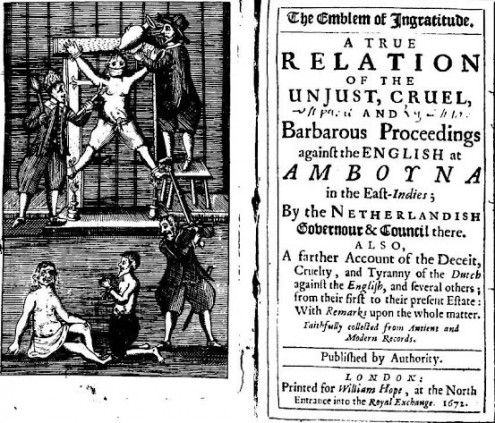British geography professor and author Miles Ogborn’s book ‘Indian Ink: Script and Print in the Making of the English East India Company’ has an image of a Dutchman performing waterboarding on an English pamphlet of 1624. The image depicts an English merchant being restrained while a Dutchman pours a jug of water over his cloth-wrapped face.
Wikipedia explains the Dutch-style waterboarding in more detail:
“It consisted of wrapping cloth around the victim’s head, after which the torturers “poured the water softly upon his head until the cloth was full, up to the mouth and nostrils, and somewhat higher, so that he could not draw breath but he must suck in all the water”. In one case, the torturer applied water three or four times successively until the victim’s “body was swollen twice or thrice as big as before, his cheeks like great bladders, and his eyes staring and strutting out beyond his forehead”.
In colonial times Dutch and English merchants fought over spices in the East, giving rise to acts of torture, with both sides publishing pamphlets to try and discredit the other, like a 17th century flame war. In 1623 on the island of Amboyna In the Molucca Islands, the Dutch East India Company led by Dutch Governor Herman van Speult was said to have tortured and executed English, Japanese and Portuguese prisoners. English pamphlets featuring ‘gory frontispieces’ were refuted in turn by Dutch publications, but the affair was never settled. Van Speult thought that English merchants together with Japanese samurai mercenaries and possibly some Portuguese planned to kill him and overwhelm the Dutch garrison once an English ship arrived for support, justifying his actions.
(Link and image: resobscura.blogspot.nl, thanks Greg!)

